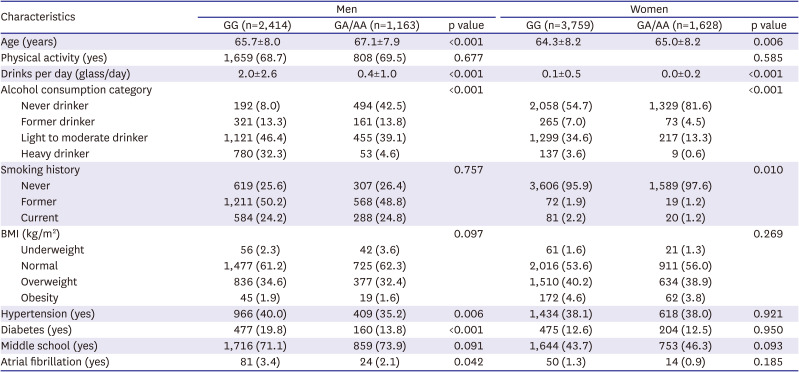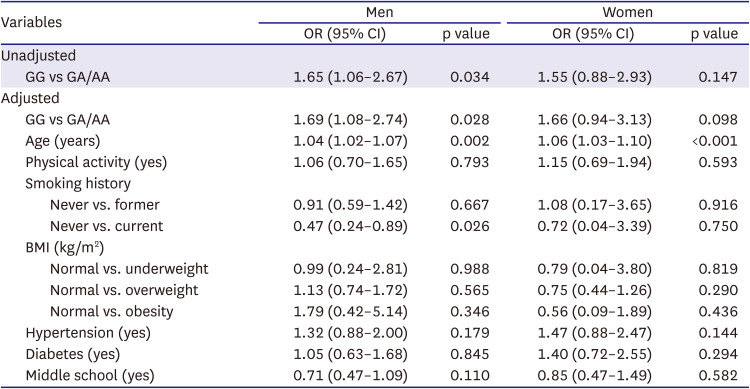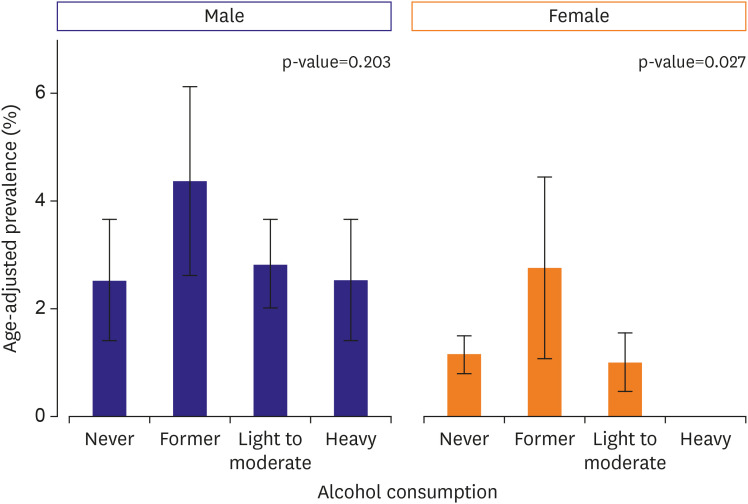1. Joung B, Lee JM, Lee KH, et al. 2018 Korean guideline of atrial fibrillation management. Korean Circ J. 2018; 48:1033–1080. PMID:
30403013.

2. Lippi G, Sanchis-Gomar F, Cervellin G. Global epidemiology of atrial fibrillation: an increasing epidemic and public health challenge. Int J Stroke. 2021; 16:217–221. PMID:
31955707.

3. Eisen A, Ruff CT, Braunwald E, et al. Sudden cardiac death in patients with atrial fibrillation: insights from the ENGAGE AF-TIMI 48 trial. J Am Heart Assoc. 2016; 5:e003735. PMID:
27402235.

4. Stewart S, Hart CL, Hole DJ, McMurray JJ. A population-based study of the long-term risks associated with atrial fibrillation: 20-year follow-up of the Renfrew/Paisley study. Am J Med. 2002; 113:359–364. PMID:
12401529.

5. Nakano Y, Ochi H, Onohara Y, et al. Genetic variations of aldehyde dehydrogenase 2 and alcohol dehydrogenase 1B are associated with the etiology of atrial fibrillation in Japanese. J Biomed Sci. 2016; 23:89. PMID:
27927211.

6. Voskoboinik A, Prabhu S, Ling LH, Kalman JM, Kistler PM. Alcohol and atrial fibrillation: a sobering review. J Am Coll Cardiol. 2016; 68:2567–2576. PMID:
27931615.
7. Kodama S, Saito K, Tanaka S, et al. Alcohol consumption and risk of atrial fibrillation: a meta-analysis. J Am Coll Cardiol. 2011; 57:427–436. PMID:
21251583.
8. Burger M, Mensink GB, Bergmann E, Pietrzik K. Characteristics associated with alcohol consumption in Germany. J Stud Alcohol. 2003; 64:262–269. PMID:
12713201.

9. Sattar N, Preiss D. Reverse causality in cardiovascular epidemiological research: more common than imagined? Circulation. 2017; 135:2369–2372. PMID:
28606949.

10. Szklo M. Epidemiology: beyond the basics. Gaithersburg (MD): Aspen;2000.
11. Davies NM, Holmes MV, Davey Smith G. Reading Mendelian randomisation studies: a guide, glossary, and checklist for clinicians. BMJ. 2018; 362:k601. PMID:
30002074.

12. National Institute on Alcohol Abuse and Alcoholism. Alcohol metabolism: an update. Alcohol Alert, No 72. Rockville (MD): National Institute on Alcohol Abuse and Alcoholism;2007.
13. Yang S, Lee J, Choi IJ, et al. Effects of alcohol consumption, ALDH2 rs671 polymorphism, and
Helicobacter pylori infection on the gastric cancer risk in a Korean population. Oncotarget. 2017; 8:6630–6641. PMID:
28036260.

14. Takagi S, Baba S, Iwai N, et al. The aldehyde dehydrogenase 2 gene is a risk factor for hypertension in Japanese but does not alter the sensitivity to pressor effects of alcohol: the Suita study. Hypertens Res. 2001; 24:365–370. PMID:
11510748.

15. Chen CH, Ferreira JCB, Joshi AU, et al. Novel and prevalent non-East Asian ALDH2 variants; implications for global susceptibility to aldehydes' toxicity. EBioMedicine. 2020; 55:102753. PMID:
32403082.

16. Jiang Q, Wang K, Shi J, Li M, Chen M. No association between alcohol consumption and risk of atrial fibrillation: a two-sample Mendelian randomization study. Nutr Metab Cardiovasc Dis. 2020; 30:1389–1396. PMID:
32540331.

17. Larsson SC, Burgess S, Mason AM, Michaëlsson K. Alcohol consumption and cardiovascular disease: a Mendelian randomization study. Circ Genom Precis Med. 2020; 13:e002814. PMID:
32367730.
18. Lu Y, Guo Y, Lin H, Wang Z, Zheng L. Genetically determined tobacco and alcohol use and risk of atrial fibrillation. BMC Med Genomics. 2021; 14:73. PMID:
33750369.

19. Kweon SS, Shin MH, Jeong SK, et al. Cohort profile: the Namwon Study and the Dong-gu Study. Int J Epidemiol. 2014; 43:558–567. PMID:
23505254.

21. Obesity: preventing and managing the global epidemic. Report of a WHO consultation. World Health Organ Tech Rep Ser. 2000; 894:i–ixii. 1–253. PMID:
11234459.
22. Kim HY, Choi CK, Kweon SS, et al. Effect modification of acetaldehyde dehydrogenase 2 rs671 polymorphism on the association between alcohol intake and blood pressure: the Dong-gu Study. J Korean Med Sci. 2020; 35:e14. PMID:
32141245.

23. Chung W, Lim S, Lee S. Why is high-risk drinking more prevalent among men than women? Evidence from South Korea. BMC Public Health. 2012; 12:101. PMID:
22304965.

24. Kamat MA, Blackshaw JA, Young R, et al. PhenoScanner V2: an expanded tool for searching human genotype-phenotype associations. Bioinformatics. 2019; 35:4851–4853. PMID:
31233103.

25. Staley JR, Blackshaw J, Kamat MA, et al. PhenoScanner: a database of human genotype-phenotype associations. Bioinformatics. 2016; 32:3207–3209. PMID:
27318201.

26. French DJ, Sargent-Cox KA, Kim S, Anstey KJ. Gender differences in alcohol consumption among middle-aged and older adults in Australia, the United States and Korea. Aust N Z J Public Health. 2014; 38:332–339. PMID:
24962802.

27. Au Yeung SL, Jiang C, Cheng KK, et al. Is aldehyde dehydrogenase 2 a credible genetic instrument for alcohol use in Mendelian randomization analysis in Southern Chinese men? Int J Epidemiol. 2013; 42:318–328. PMID:
23243119.

28. Im SI, Chun KJ, Park SJ, Park KM, Kim JS, On YK. Long-term prognosis of paroxysmal atrial fibrillation and predictors for progression to persistnt or chronic atrial fibrillation in the Korean population. J Korean Med Sci. 2015; 30:895–902. PMID:
26130952.

29. Lip GY, Hee FL. Paroxysmal atrial fibrillation. QJM. 2001; 94:665–678. PMID:
11744787.

30. Huang YH, Chang KH, Lee YS, Chen CM, Chen YC. Association of alcohol dehydrogenase and aldehyde dehydrogenase polymorphism with spontaneous deep intracerebral haemorrhage in the Taiwan population. Sci Rep. 2020; 10:3641. PMID:
32107439.









 PDF
PDF Citation
Citation Print
Print




 XML Download
XML Download